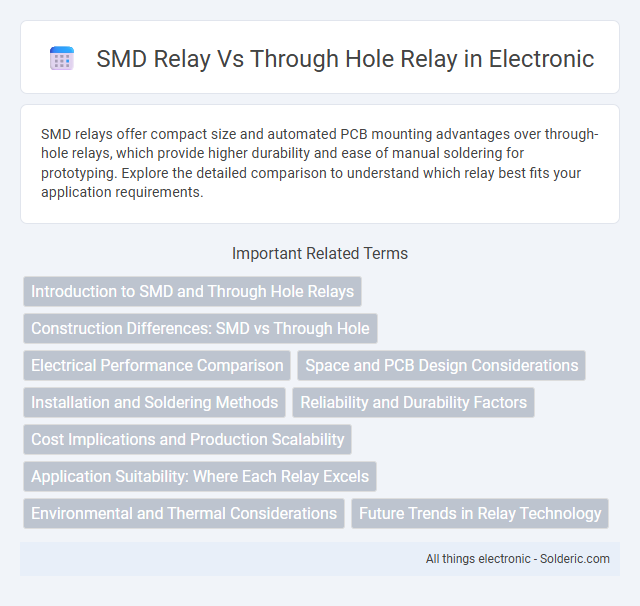SMD relays offer compact size and automated PCB mounting advantages over through-hole relays, which provide higher durability and ease of manual soldering for prototyping. Explore the detailed comparison to understand which relay best fits your application requirements.
Comparison Table
| Feature | SMD Relay | Through Hole Relay |
|---|---|---|
| Mounting Type | Surface Mount Device (SMD) | Leaded, inserted through PCB holes |
| Size | Compact, low profile | Larger, bulkier |
| Assembly Process | Automated pick-and-place | Manual or wave soldering |
| Mechanical Strength | Lower mechanical robustness | Higher mechanical stability |
| Electrical Performance | Suitable for low to moderate currents | Handles higher currents reliably |
| Thermal Management | Limited heat dissipation | Better heat dissipation |
| Application | Compact electronics, consumer devices | Industrial, heavy-duty equipment |
| Cost | Generally lower cost for mass production | Higher cost due to manual assembly |
Introduction to SMD and Through Hole Relays
SMD relays (Surface-Mount Device relays) are designed for automated PCB assembly with compact footprints and low profile, making them ideal for high-density electronic applications. Through hole relays feature long leads that insert into drilled holes on circuit boards, offering mechanical stability and suitability for environments requiring robust connections. Your choice between SMD and through hole relays depends on factors like assembly method, board space constraints, and mechanical durability requirements.
Construction Differences: SMD vs Through Hole
Surface Mount Device (SMD) relays feature compact, lightweight construction with flat terminals designed for automated PCB assembly, enabling higher component density and faster production. Through Hole relays have larger, robust bodies with leads that pass through PCB holes, providing stronger mechanical stability and better performance in high-vibration environments. The construction differences primarily influence mounting techniques, footprint size, and mechanical resilience between SMD and Through Hole relays.
Electrical Performance Comparison
SMD relays offer faster switching speeds and lower coil power consumption compared to through-hole relays, making them ideal for compact, high-frequency applications. Through-hole relays generally provide higher current ratings and better mechanical robustness, suitable for heavy-duty or industrial use. Your choice depends on the required electrical performance, balancing switching efficiency and load handling capacity.
Space and PCB Design Considerations
SMD relays offer significant space savings on PCBs due to their compact, low-profile design, enabling higher component density and more efficient use of board real estate. Through hole relays require larger pads and holes, increasing PCB size and complicating automated assembly processes. Your choice between SMD and through hole relays impacts overall PCB layout complexity, manufacturing cost, and device miniaturization.
Installation and Soldering Methods
SMD relays are surface-mounted directly onto the PCB pads using reflow soldering, which enables automated high-speed assembly and reduced thermal stress on components. Through-hole relays require leads to be inserted into drilled holes on the PCB and soldered, typically via wave soldering or manual soldering, providing stronger mechanical bonds suitable for high-vibration environments. The installation of SMD relays supports compact designs and higher component density, whereas through-hole relays demand more board space but offer enhanced durability and easier prototyping.
Reliability and Durability Factors
SMD relays offer enhanced reliability due to their compact size and automated assembly, reducing solder joint failures and improving vibration resistance compared to through hole relays. Through hole relays typically provide greater mechanical stability and durability in high-stress environments, thanks to their robust leads and stronger physical connections. When selecting a relay for your application, consider that SMD relays excel in long-term performance in compact, low-profile designs, while through hole relays are favorable for heavy-duty, high-reliability requirements.
Cost Implications and Production Scalability
SMD relays typically offer lower production costs due to automated assembly processes and reduced material usage, enhancing scalability for high-volume manufacturing. Through-hole relays incur higher costs from manual or selective soldering and bulkier packaging, which limits efficient large-scale production. Choosing SMD relays optimizes cost-effectiveness and scalability in modern electronic manufacturing environments.
Application Suitability: Where Each Relay Excels
Surface-mount device (SMD) relays excel in compact, high-frequency electronic applications such as telecommunications, signal routing, and portable devices due to their small size and low coil power consumption. Through-hole relays prove ideal for industrial and automotive environments requiring robust mechanical strength, higher current handling, and easier manual assembly or replacement on printed circuit boards (PCBs). Each relay type fits specific application needs by balancing size constraints, power requirements, and environmental durability.
Environmental and Thermal Considerations
SMD relays offer superior thermal performance due to their low thermal resistance and efficient heat dissipation on PCB surfaces, making them ideal for compact, high-density electronic designs. Through hole relays, while robust, exhibit higher thermal mass which can lead to slower heat dissipation and potential thermal stress under prolonged high-current operation. Environmentally, SMD relays contribute to reduced material usage and are more compatible with automated assembly processes, minimizing waste and lowering the overall carbon footprint in manufacturing.
Future Trends in Relay Technology
SMD relays continue to dominate the market due to their compact size, high-speed switching, and compatibility with automated PCB assembly, enabling enhanced miniaturization in electronic devices. Through-hole relays, while offering robust mechanical stability and higher current capacity, are increasingly integrated into legacy systems and applications requiring durability under harsh environmental conditions. Advances in solid-state relay technology and the integration of IoT-enabled smart relays indicate future trends toward lower power consumption, improved reliability, and real-time monitoring capabilities across both SMD and through-hole relay platforms.
SMD relay vs through hole relay Infographic

 solderic.com
solderic.com